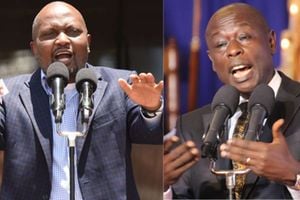Media plays a critical role in ending FGM in Kenya

President Uhuru Kenyatta and First Lady Margaret Kenyatta receive a copy of the National Policy for Eradication of Female Genital Mutilation from Cabinet Secretary for Public Service, Gender, Senior Citizens Affairs and Special Programmes Prof Margaret Kobia, during its launch at State House, Nairobi in 2019.
At the age of seven, Zipporah Mwangangi was subjected to Female Genital Mutilation. Thirty years later, the excruciating pain she was subjected to still sends chills down her spine as she recounts the events of the day she almost lost her life after she bled profusely.
In Kenya, Zipporah accounts for four million girls and women who have undergone Female Genital Mutilation and out of these, according to data from UNICEF.
As the world marks The International Day of Zero Tolerance Towards Female Genital Mutilation today, more interventions are required for Kenya to eliminate the vice. In 2019, President Uhuru Kenyatta made a landmark declaration that by 2022, Kenya will have eliminated FGM, a statement received with mixed reactions from women’s rights defenders, many of whom expressed concern that the President’s goal was unrealistic due to the high prevalence rates of the vice and the morphing of the vice including “medicalization” and trans-border FGM.
So, what interventions are required to end FGM in the country? Who are the stakeholders in the fight against FGM? Does the media have a role in the abandonment of FGM?
Efforts to end FGM have been ramped up significantly in the last 10 years or so. Globally, it is seen as an issue relating to gender equality, a serious human rights violation, and an extreme form of violence and discrimination against women and girls.
Eliminate FGM
In efforts to eliminate FGM, the media remains pivotal in raising awareness to protect the rights of women and girls. As the government endeavours to reach its target to end, the media can fulfil its part by increasing public awareness on why and how FGM is a human rights violation.
By educating and informing the masses, the media is critical in addressing how FGM robs girls their right to an education, which contravenes the Children Act, The Penal Code, the Constitution and the Prohibition of Female Genital Mutilation Act 2011.
Agenda setting by the media steers conversations on the topic and encourages public engagement. This can be done by reporting on FGM authoritatively factually and sensitively. More often than not, FGM is a precursor to early marriages.
Girls who undergo the “cut” are initiated into womanhood and married off at an early age and against their wish. Therefore, their right to an education is curtailed, and so is their freedom of choice. The lack of an education deprives them of the opportunity to shape their lives and many are often caught up in the cycle of Gender Based Violence and poverty.
The media, therefore, has a responsibility to break down the violation of the rights of girls and women subjected to FGM, in a bid to educate communities that practice it to get alternative rites of passage that are not dehumanizing and that promote equality for women and girls, men and boys.
The media has a duty to amplify stories that are survivor-centred as well as amplifying the voices of stakeholders supporting the anti-FGM movement on the ground.
Women’s rights-based organisations, Community Based Organisations (CSOs) and government agencies involved in the fight against FGM form a rich resource for information sourcing for journalists. Their work can enrich media coverage of FGM by enabling journalists reach remote areas where the “cut” is practices, get first-hand information on the problem and barriers hindering the elimination of the practice.
Most importantly, creating linkages between the media and the various stakeholders is a two-way traffic for parties involved because first, the media highlights the issues and secondly, the CSOs and government agencies use the media as a platform to inform the masses on their work.
This collaboration promotes synergy and encourages solution journalism, where journalists not only highlight societal problems, but also guide in offering solutions to the problems.
The media, in its reporting, has a role to play in ensuring the use of proper terminology while covering FGM. For instance, the appropriate term to refer to the practice is FGM and not “circumcision”. In addition, journalists, especially those working in community media outlets which broadcast in vernacular language, must do their due diligence to use appropriate language in reference to the vice. This will prevent stigmatisation and ridicule and shape the society’s mindset in addressing a societal problem.
The media must call out duty bearers in the eliminating FGM. They have a role to play in putting the government to task in ensuring the rights of women and girls are not violated, the police, who must act to enforce the law, the Judiciary who have a role to play in ensuring justice for FGM survivors is delivered and the local State administrators e.g chiefs who must ensure girls get an education and are not married off.
The media’s role in education should be centred on how FGM indelibly affects the lives of girls who in the short-term, endure pain, shock, excessive bleeding, infections, and difficulty in passing urine, as well as long-term consequences for their sexual and reproductive health, mental health and self-esteem.
Unless every single country bans FGM and implements that ban, it will continue to be a major challenge to end it within the next decade.
The writer is the Gender Media Trainer at Journalists for Human Rights, Voice for Women and Girls Rights. [email protected]





